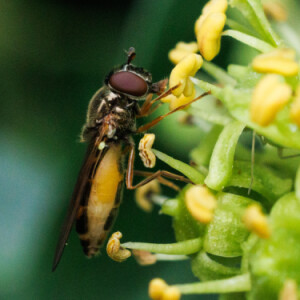Ivy Bee
The weather went off today, taking me with it - I could barely lift my head off the pillow this morning, and wound up asleep again this afternoon. Maybe my love of beetles and bugs is leading me to adopt their lifestyles, and my body's preparing to go into diapause for the next few months? If that's the case, I'd better get on with the Christmas shopping as soon as.
After a few fruitless forays to the kitchen window over the course of the morning, and much pointless maunging ("Just look at that light! It's horrible! What am I going to photograph today? Seriously though? I can't work in these conditions!", etc., etc), I suddenly bethought me of the flowering ivy, got a grip, donned shoes, grabbed a camera, and set off on a tour of the village's hedgerows. Then stomped back home, muttering dark curses, when the battery I hadn't checked before leaving the house ran out, got a fresh one, and slammed off out again.
The ivy was busy with feasting insects of all kinds, but one particular patch that runs all the way along the garden wall of a near neighbour was literally teeming with Ivy Bees. I tried to make a rough count, but they were so hyped up and skittish that I couldn't get beyond fifty. I suspect there were probably at least twice that number, which is a satisfying thought because this late solitary bee is still a relative newcomer to the UK, and when I first saw it here, just a few years ago, it was never present in large numbers.
This individual is a female, which you can see by the long hairs on her back leg - called the pollen brush, or scopa - on which she'll collect the pollen with which she'll stock her nest cells. She will dig these close to the nests of other females, ideally on a sparsely vegetated south-facing slope - but these little bees are resourceful and resilient, and will make do with vegetable patches, flower beds, or even lawns, if no better site is available. Although she wasn't foraging for nest supplies today, it's highly unlikely that she's still unmated, because male Ivy Bees, which hatch first, patrol the nest aggregations with great diligence until the females emerge, and then leap on them in a competitive mating frenzy.
I've added a second photo this evening, to show that it's not just the ivy bees who relish the autumnal feast offered by the flowering ivy. This tiny hoverfly is a female Melanostoma - probably M. mellinum, though my angle wasn't the best for seeing the facial features that distinguish this from the equally common M. scalare. As you can see from her swollen abdomen she's already carrying eggs, and the protein in the pollen grains she was delicately lifting from the ivy anthers will help her to develop them.


Comments
Sign in or get an account to comment.


